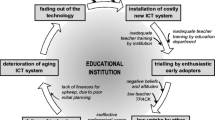Abstract
The purpose of this article is to examine how, over time, the major definitions of the field of educational technology have reflected changes in the field itself. Major definitions from the early 1900s through 1994 are reviewed and compared. Each definition is discussed in terms of the events and ideas that were current at that time. Major changes in the field, as reflected by the definitions, are identified and thoughts regarding future definitions are presented.
Similar content being viewed by others
References
Allen, W.H. (1960). Editor's foreword. AV Communication Review, 8(1), 3–4.
Association for Educational Communications and Technology (1977). Educational technology: Definition and glossary of terms. Washington, DC: Association for Educational Communications and Technology.
Berrien, F.K. (1976). A general systems approach to organizations. In M.D. Dunnette (Ed.), Handbook of industrial psychology, Palo Alto, CA: Davies-Black.
Cohen, S. (1965). Audiovisual instruction. Audiovisual instruction, 10, 196–199.
Commission on Instructional Technology (1970). To improve learning: An evaluation of instructional technology. Washington, D.C: United States Government Printing Office.
Dale, E. (1953). What does it mean to communicate? AV Communication Review, 1, 3–5.
Dick, W. (1987). A history of instructional design and its impact on educational psychology. In J.A. Glover and R.R. Ronning (Eds.), Historical foundations of educational psychology, New York: Plenum.
Dorris, A.V. (1928). Visual instruction in the public schools. Boston, MA: Ginn.
Ely, D.P. (Ed.). (1963). The changing role of the audio-visual process in education: A definition and a glossary of related terms. AV Communication Review, 11(1).
Ely, D.P. (1972). The field of educational technology: A statement of definition. Audiovisual Instruction, 17(8), 36–43.
Emery, J.N. (1925). The scope of visual instruction. Educational Screen, 3, 11–12.
Finn, J.D. (1953). Professionalizing the audio-visual field. AV Communication Review, 1(1), 6–18.
Finn, J.D. (1960). Technology and the instructional process. AV Communication Review, 8(1) 5–26.
Finn, J.D. (1965). Instructional technology. Audiovisual instruction, 10, 192–194.
Gagné, R.M. (1965). The analysis of instructional objectives for the design of instruction. In R. Glaser (Ed.), Teaching machines and programmed learning, II: Data and directions. Washington, DC: National Education Association.
Hoban, C.F., Jr. (1977). A systems approach to audio-visual communications: The Okoboji 1956 keynote address. In Cochran, L.W. (Ed.), Okoboji: A 20 year review of leadership 1955–1974. Dubuque, IA: Kendall/Hunt, 67–72.
Hoban, C.F., Hoban, C.F., Jr., & Zisman, S.B. (1937). Visualizing the curriculum. New York: Cordon.
Lumsdaine, A.A. (1964). Educational technology, programmed learning, and instructional science. In E.R. Hilgard (Ed.), Theories of learning and instruction: The sixty-third yearbook of the National Society for the Study of Education, Part I. Chicago: University of Chicago Press.
Reiser, R.A. (1987). Instructional technology: A history. In R.M. Gagné (Ed.), Instructional technology: Foundations. Hillsdale, NJ: Lawrence Erlbaum.
Richey, R.C., & Seels, B. (1994). Defining a field: A case study of the development of the 1994 definition of instructional technology. In D.P. Ely (Ed.), Educational media and technology yearbook: 1994. Englewood, CO: Libraries Unlimited.
Saettler, P. (1990). The evolution of American educational technology. Englewood, CO: Libraries Unlimited.
Scriven, M. (1967). The methodology of evaluation. In Perspectives of curriculum evaluation (American Educational Research Association Monograph Series on Curriculum Evaluation, No. 1). Chicago: Rand McNally.
Seels, B.B., & Richey, R.C. (1994). Instructional technology: The definition and domains of the field. Washington, DC: Association for Educational Communications and Technology.
Shannon, C.E., & Weaver, W. (1949). The mathematical theory of communication. Urbana, IL: University of Illinois Press.
Torkelson, G.M. (1965). Learning resources. Audiovisual instruction, 10, 199–200.
Twyford, L.C. (1965). Educational communications. Audiovisual instruction, 10, 194–195.
Author information
Authors and Affiliations
Rights and permissions
About this article
Cite this article
Reiser, R.A., Ely, D.P. The field of educational technology as reflected through its definitions. ETR&D 45, 63–72 (1997). https://doi.org/10.1007/BF02299730
Issue Date:
DOI: https://doi.org/10.1007/BF02299730




